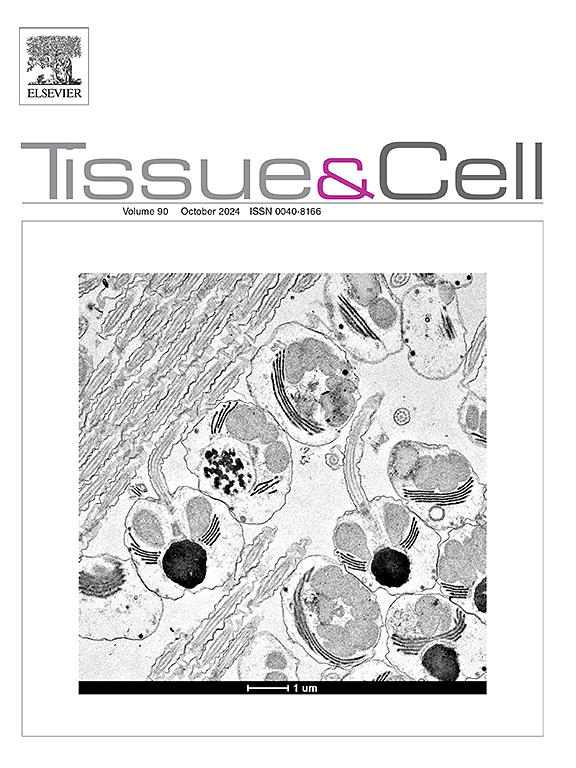通过网络药理学和实验验证,planatoside A抗糖尿病肾病细胞外基质积累、炎症和系膜细胞增殖的机制
IF 2.7
4区 生物学
Q1 ANATOMY & MORPHOLOGY
引用次数: 0
摘要
糖尿病肾病(DN)是终末期肾病(ESRD)的主要病因,迫切需要探索有效的预防和控制策略。越来越多的证据表明,抑制异常系膜细胞(MCs)增殖,特别是在DN的早期阶段,是减缓DN进展的关键治疗策略。黄芪苷A (planatoside A, CA)是一种主要的黄酮类化合物,具有显著的肾保护作用。本研究通过建立糖尿病小鼠模型和高糖诱导小鼠系膜细胞模型,探讨CA的肾保护机制,并利用网络药理学方法预测CA的分子靶点和信号通路。组织病理学分析显示,CA减轻了肾小球间质纤维化、肾小球基底膜增厚、系膜基质扩张、肾小球硬化和纤维性胶原沉积等关键肾脏病理改变。此外,CA抑制hg诱导的系膜细胞外基质(ECM)积累、炎症反应和细胞增殖。通过网络药理学,8个核心基因(TNF-α、AKT1、HSP90AA1、MMP9、PPARG、SRC、PTGS2和MMP2)被确定为DN中CA的关键靶点,主要与炎症反应和ECM沉积相关。分子对接分析证实CA对这些炎症和ecm相关基因具有高结合亲和力。本研究表明CA通过抑制炎症通路和ECM沉积有效减轻DN的肾损伤,从而为其治疗潜力提供了新的见解。这些发现为发展以中医药为基础的干预治疗DN提供了新的视角。本文章由计算机程序翻译,如有差异,请以英文原文为准。
Mechanisms of Complanatoside A against extracellular matrix accumulation, inflammation and proliferation of mesangial cells in diabetic nephropathy through network pharmacology and experimental validation
Diabetic nephropathy (DN) is the leading cause of end-stage renal disease (ESRD) worldwide, underscoring the urgent need to explore effective strategies for its prevention and control. Accumulating evidence indicates that inhibition of abnormal mesangial cells (MCs) proliferation, particularly during the early stages of DN, represents a critical therapeutic strategy for attenuating the progression of DN. Complanatoside A (CA), a major flavonoid derived from Semen Astragali Complanati, has demonstrated significant reno-protective properties. In this study, diabetic mouse models and high-glucose (HG)-induced mouse mesangial cell models were established to investigate the reno-protective mechanisms of CA. Furthermore, network pharmacology was employed to predict molecular targets and signaling pathways. Histopathological analysis revealed that CA alleviated key renal pathological changes, including glomerular interstitial fibrosis, thickening of the glomerular basement membrane, mesangial matrix expansion, glomerulosclerosis, and fibrillar collagen deposition. Furthermore, CA inhibited HG-induced mesangial extracellular matrix (ECM) accumulation, inflammatory responses, and cellular proliferation. Through network pharmacology, eight core genes (TNF-α, AKT1, HSP90AA1, MMP9, PPARG, SRC, PTGS2, and MMP2) were identified as critical targets of CA in DN and were primarily associated with inflammatory responses and ECM deposition. Molecular docking analysis confirmed that CA exhibited high binding affinity for these inflammation- and ECM-related genes. This study demonstrated that CA effectively mitigated renal injury in DN by suppressing inflammatory pathways and ECM deposition, thus providing novel insights into its therapeutic potential. These findings offer new perspectives for the development of traditional Chinese medicine-based interventions for the treatment of DN.
求助全文
通过发布文献求助,成功后即可免费获取论文全文。
去求助
来源期刊

Tissue & cell
医学-解剖学与形态学
CiteScore
3.90
自引率
0.00%
发文量
234
期刊介绍:
Tissue and Cell is devoted to original research on the organization of cells, subcellular and extracellular components at all levels, including the grouping and interrelations of cells in tissues and organs. The journal encourages submission of ultrastructural studies that provide novel insights into structure, function and physiology of cells and tissues, in health and disease. Bioengineering and stem cells studies focused on the description of morphological and/or histological data are also welcomed.
Studies investigating the effect of compounds and/or substances on structure of cells and tissues are generally outside the scope of this journal. For consideration, studies should contain a clear rationale on the use of (a) given substance(s), have a compelling morphological and structural focus and present novel incremental findings from previous literature.
 求助内容:
求助内容: 应助结果提醒方式:
应助结果提醒方式:


